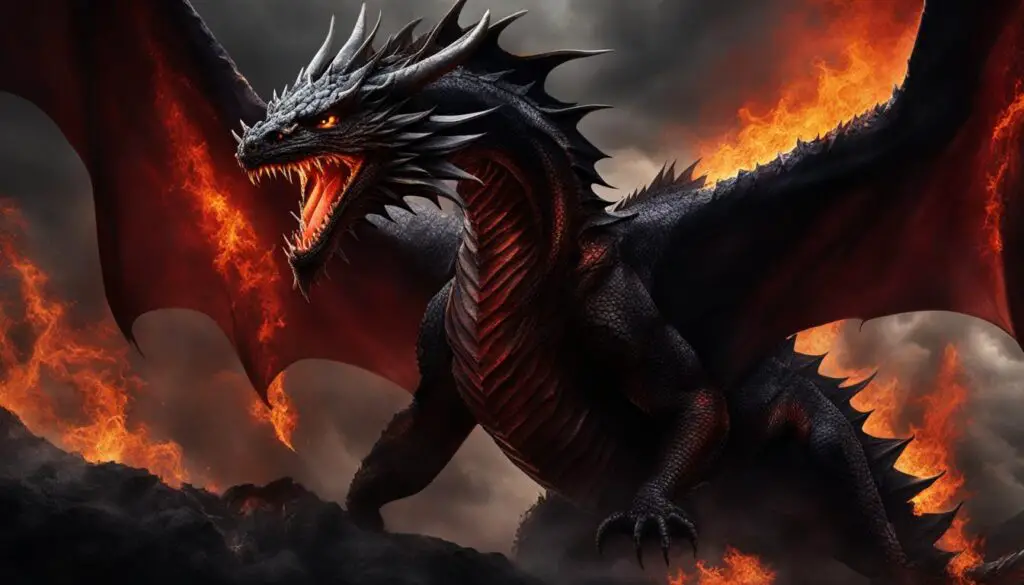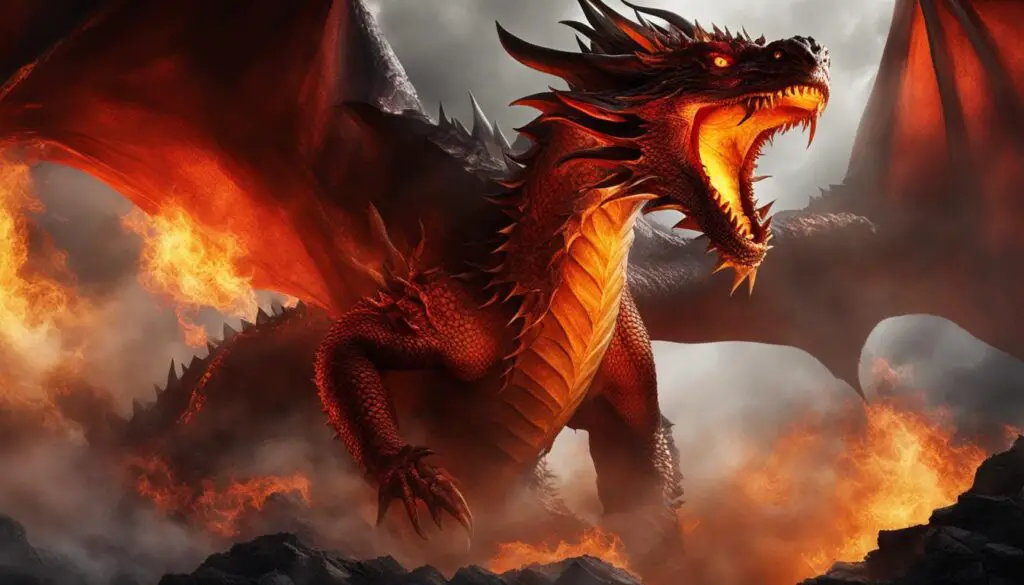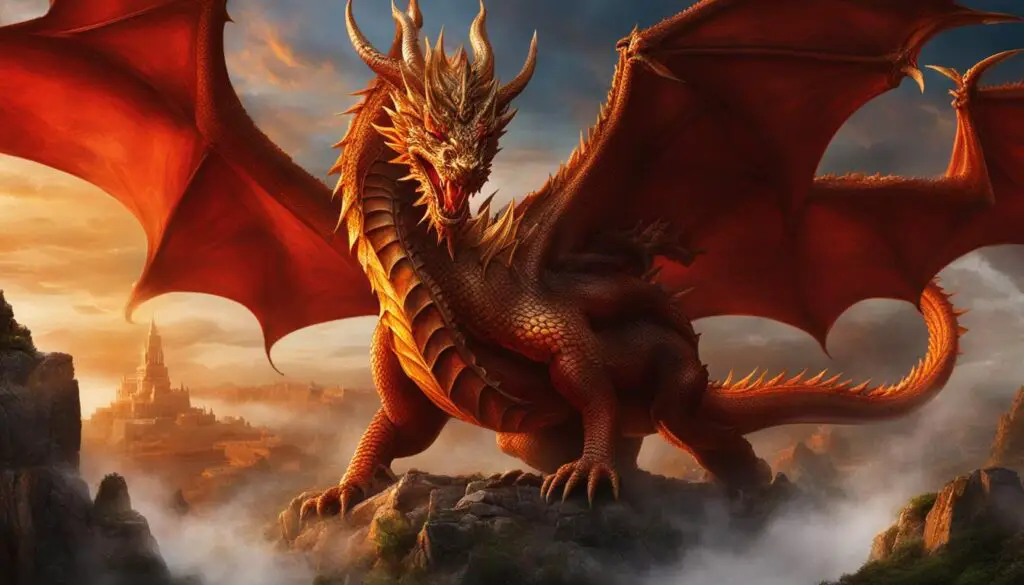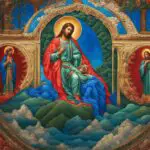The dragon holds significant symbolism in the Holy Bible. It is mentioned in two different contexts – the Old Testament and the New Testament. In the Old Testament, the dragon is referred to as Leviathan, described as a powerful sea creature with some similarities to a dinosaur. The dragon represents the awesome power of God and serves as a reminder of His sovereignty. In the New Testament, Satan is referred to as a dragon in the book of Revelation. The dragon symbolizes power and is associated with Satan’s authority and evil nature. The dragon, in both instances, highlights the superiority of God over any physical or spiritual being.
Key Takeaways:
- The dragon symbolizes evil and chaos in the Bible.
- Leviathan, mentioned in the Old Testament, represents God’s power and uniqueness.
- Satan is referred to as a dragon in the New Testament, symbolizing his authority and evil nature.
- The dragon highlights the ongoing battle between good and evil.
- Dragons hold diverse interpretations and cultural significance in different mythologies and cultures.
Leviathan: The Dragon of the Old Testament
Leviathan, the dragon mentioned in the Old Testament, holds a prominent place in biblical texts. It appears in several passages, including Job, Psalms, and Isaiah, where it is described as a fearsome and powerful creature. The book of Job portrays Leviathan as a unique creature, emphasizing its characteristics such as its strength and scales:
“Can you pull in Leviathan with a fishhook or tie down its tongue with a rope? Can you put a cord through its nose or pierce its jaw with a hook? Will it keep begging you for mercy? Will it speak to you with gentle words? Will it make an agreement with you for you to take it as your slave for life?” (Job 41:1-4)
These verses highlight the immense power and untamable nature of Leviathan. Its portrayal as a sea monster or dinosaur-like creature further emphasizes the awe-inspiring strength that symbolizes God’s own power.
The Symbolic Meaning of Leviathan
Leviathan serves as a symbol of God’s dominion and sovereignty over all creation. Its untamable nature and fearsome power remind us that there is no being greater than God. The unique characteristics of Leviathan, such as its scales and fiery breath, set it apart from any other creature, emphasizing its status as a symbol of God’s might. By including Leviathan in the Old Testament, the biblical writers sought to emphasize the incomparable power and authority of God.
| Text | Reference |
|---|---|
| Job | Job 3:8, Job 41:1-34 |
| Psalms | Psalms 74:13-14, Psalms 104:25-26 |
| Isaiah | Isaiah 27:1 |
These passages from Job, Psalms, and Isaiah provide a glimpse into the symbolic significance of Leviathan and its representation of God’s power and might. The description of Leviathan as a creature of unmatched strength and power serves as a metaphor for the supremacy of God over all creation.
Leviathan: A Unique Creature or Dinosaur?
While the exact nature of Leviathan remains a topic of debate and interpretation, some scholars draw comparisons between Leviathan and dinosaurs. The characteristics attributed to Leviathan, such as its scaly skin, monstrous size, and fearsome power, bear similarities to descriptions of dinosaurs in modern scientific understanding. This connection between Leviathan and dinosaurs highlights the ancient writers’ attempt to describe a creature of extraordinary strength and majesty, using the knowledge and understanding available to them.
In conclusion, Leviathan, as depicted in the Old Testament, symbolizes God’s power and authority over all creation. Its unique characteristics and fearsome power serve to emphasize the incomparable might of God. Whether seen as a dinosaur or a mythical sea monster, Leviathan’s representation in biblical texts serves to remind believers of the unmatched power and sovereignty of God.
Satan: The Dragon of the New Testament
In the New Testament, Satan is referred to as a dragon in the book of Revelation. This powerful imagery portrays Satan as a symbol of power and authority, highlighting his role as the ultimate evil. Satan is described as an evil angel, a cherub who was cast out of heaven due to his rebellion against God. The term “dragon” is used as another name for Satan, signifying his real power and influence over the forces of darkness.
The book of Revelation contains multiple references to the dragon imagery. It is associated with Satan in passages such as Revelation 12:3, 4, 7, 9, 13, 17; 13:1, 2, 4, 11; 16:13; and 20:2. These verses depict the dragon as a formidable adversary, engaged in a spiritual battle against God and His holy people. Through this symbol, the book of Revelation emphasizes the ongoing struggle between good and evil, ultimately pointing towards the triumph of divine forces over the powers of chaos and destruction.
“And the great dragon was thrown down, that ancient serpent, who is called the devil and Satan, the deceiver of the whole world—he was thrown down to the earth, and his angels were thrown down with him.” – Revelation 12:9
The use of dragon imagery in the New Testament serves to highlight the power, authority, and evil nature of Satan. The dragon symbolizes his role as the ultimate adversary of God, engaged in a constant battle against the forces of good. Through this symbolism, the New Testament underscores the eternal struggle between light and darkness, emphasizing the ultimate victory of God over the forces of evil.

The Influence of Dragon Symbolism
The dragon’s symbolic representation of power, evil, and chaos has had a profound influence on various aspects of culture and literature. Throughout history, dragons have been featured in myths, legends, and works of art, often embodying themes of conflict, heroism, and the battle between good and evil. The dragon as a name for Satan has become a prominent motif in storytelling, serving as a powerful symbol that highlights the ongoing struggle between light and darkness.
Mythical Creatures and Cultural Significance
Dragons, as mythical creatures, have captivated the imaginations of people across different cultures and have gained significant cultural significance throughout history. In Chinese culture, dragons are revered as positive symbols, representing power, strength, and good fortune. They are believed to bring blessings and prosperity and are often associated with the emperor and imperial power. Chinese dragons are depicted as benevolent creatures, with long bodies, scaly skin, and the ability to control water. They are seen as protectors and bringers of harmony.
On the other hand, in Middle Eastern culture, dragons have taken on a more sinister connotation. They are often seen as evil symbols, associated with chaos, destruction, and malevolence. These dragons are depicted as fearsome creatures with sharp fangs, fiery breath, and the ability to cause harm. They represent the forces of darkness and are often portrayed as adversaries to heroes or gods in folklore and mythology.
The contrasting interpretations of dragons in Chinese and Middle Eastern cultures exemplify the diverse symbolic meanings attached to these mythical creatures. While the Chinese view dragons as positive and auspicious beings, the Middle Eastern perception portrays them as menacing and malevolent. These cultural differences highlight the nuanced interpretations and the rich tapestry of folklore surrounding dragons.
Chinese Dragons in Art and Symbolism
“The Chinese dragon is an important cultural symbol and has been depicted in various forms of art, including paintings, sculptures, and textiles. It represents prosperity, luck, and happiness.”
The imagery of dragons has left a lasting impact on Chinese art and symbolism. Chinese dragons can be seen in various artistic mediums, including paintings, sculptures, and textiles. They are often depicted in vibrant colors, with long bodies and intricate scales. Chinese dragon art represents prosperity, luck, and happiness and is highly revered and sought after.
Furthermore, dragons play a significant role in traditional Chinese festivals, such as the Dragon Boat Festival and the Lantern Festival. These celebrations showcase the cultural importance of dragons and their enduring presence in Chinese society.
| Chinese Dragon Symbolism | Meaning |
|---|---|
| Power and Strength | The dragon symbolizes immense power and strength, representing the emperor’s authority and leadership. |
| Good Fortune | Dragons are associated with good luck and are believed to bring blessings and abundance. |
| Wisdom and Intelligence | Chinese dragons are often depicted as wise and intelligent beings, symbolizing wisdom and knowledge. |
The symbolism associated with Chinese dragons reflects the values and beliefs held in Chinese culture, emphasizing the importance of power, luck, and wisdom.
Dragons in Apocalyptic Literature
The dragon holds significant symbolism in apocalyptic literature, particularly in the book of Revelation. As a representation of chaos and destruction, the dragon embodies the forces of evil in the battle between good and evil. It serves as a powerful symbol that underscores the ongoing struggle between divine forces and the powers of darkness.
In apocalyptic texts, the dragon’s presence highlights the ultimate triumph of God over the forces of chaos and destruction. It signifies the victory of good over evil and serves as a reminder of the divine power that will ultimately prevail. The dragon’s symbolism in apocalyptic literature adds depth and meaning to the narrative, depicting the cosmic battle between light and darkness.
Apocalyptic literature often utilizes vivid imagery and symbolism to convey profound spiritual truths. The dragon, as a prominent symbol in this genre, represents the primal forces of chaos and destruction. It embodies the opposition to God’s order and serves as a reminder of the ongoing battle between good and evil that will culminate in the final victory of divine forces.

The Battle of Good and Evil
The dragon’s portrayal in apocalyptic literature reflects the larger theme of the battle between good and evil. It emphasizes the struggle that humanity faces in the spiritual realm and underscores the importance of aligning oneself with the forces of light. The dragon serves as a powerful reminder of the consequences of embracing darkness and the ultimate fate that awaits those who oppose God’s divine order.
| Symbolism | Description |
|---|---|
| Chaos | The dragon represents chaos and disruption, highlighting the destructive nature of evil forces. |
| Destruction | The dragon symbolizes destruction on a cosmic scale, reflecting the devastating impact of evil. |
| Battle | The dragon embodies the ongoing battle between good and evil, signifying the ultimate triumph of divine forces. |
The dragon’s symbolism in apocalyptic literature serves as a call to action for believers, urging them to stand firm in their faith and resist the allure of darkness. It reminds readers that even in the face of chaos and destruction, God’s power and authority will ultimately prevail.
Dragon References in Specific Bible Verses
Throughout the Bible, there are several references to dragons or the use of dragon imagery to convey specific messages. These passages provide deeper insights into the symbolic meaning and significance of dragons in biblical texts. Let’s explore some of these verses:
Ezekiel 29:3
In Ezekiel 29:3, we see the mention of a great dragon as a representation of Pharaoh, the king of Egypt. This imagery emphasizes the power and authority of Pharaoh, highlighting his dominance over his subjects. It serves as a reminder of the challenges faced by the children of Israel under the rule of the Egyptian empire.
Psalms 74:13
“Thou didst divide the sea by thy strength: thou brakest the heads of the dragons in the waters.”
In Psalms 74:13, the heads of dragons being broken symbolizes the display of God’s power and triumph over chaos. It signifies His ability to bring order and victory over the forces of darkness. This verse serves as an encouragement to trust in God’s sovereignty, even in the face of seemingly insurmountable challenges.
Isaiah 34:13
“And thorns shall come up in her palaces, nettles and brambles in the fortresses thereof: and it shall be an habitation of dragons, and a court for owls.”
Isaiah 34:13 describes the desolation and abandonment of certain places using the imagery of dragons inhabiting them. This verse paints a picture of destruction and serves as a warning of the consequences of turning away from God. It reminds us of the importance of staying faithful and obedient to His will.
Revelation
The book of Revelation contains various passages that describe a great red dragon with multiple heads and horns. This dragon symbolizes Satan’s power and authority, representing the forces of evil that oppose God’s kingdom. The dragon’s presence in Revelation signifies the ongoing battle between good and evil, emphasizing the ultimate victory of God over the forces of darkness.

In these Bible verses, we see the use of dragon imagery to convey powerful messages about authority, power, triumph, and the ongoing battle between good and evil. By understanding the context and symbolism of these references, we gain a deeper appreciation for the rich and multifaceted symbolism of dragons in the Bible.
| Verse | Description |
|---|---|
| Ezekiel 29:3 | Mention of a great dragon as a representation of Pharaoh, the king of Egypt |
| Psalms 74:13 | Heads of dragons being broken, symbolizing God’s power and triumph |
| Isaiah 34:13 | Inhabitation of dragons in desolated places, signifying destruction and abandonment |
| Revelation | Description of a great red dragon representing Satan’s power and authority |
Dragon in Creation Myths
Dragons play a significant role in creation myths across different cultures, often depicted as water-dwelling beasts associated with chaos and disorder. These mythical creatures symbolize the primordial forces that governed the world’s origin and represent the challenge of bringing order out of chaos. Dragons in creation myths underscore the transformative power of creation and the resilience of divine order.
In various cultural traditions, dragons are portrayed as powerful beings closely linked to water, symbolizing the turbulent and unpredictable aspects of creation. They embody the forces of chaos and disorder, highlighting the inherent challenges in establishing and maintaining order in the universe.
The dragon is a symbol of chaos and disorder in creation myths, representing the primordial forces that must be tamed in order to bring forth order and harmony.
Dragons in creation myths remind us that the world is not always predictable or controllable. They serve as a reminder of the delicate balance between order and chaos, and the continuous struggle to establish harmony in the world. By overcoming the challenges posed by dragons, both mythical and metaphorical, humanity can aspire to create a world that reflects divine order and purpose.
| Culture | Dragon Symbolism |
|---|---|
| Chinese | In Chinese mythology, dragons are revered as auspicious creatures, associated with power, wisdom, and good fortune. They symbolize yang, the principle of heaven and activity. |
| Middle Eastern | In Middle Eastern mythology, dragons are often depicted as malevolent creatures, representing chaos, destruction, and evil. |
| European | In European folklore, dragons are often portrayed as fierce, fire-breathing creatures guarding treasure or terrorizing villages. They symbolize power, strength, and primal instincts. |
These diverse interpretations of dragons in various creation myths reflect the cultural and historical context in which they originated. Despite the differences, dragons consistently embody the symbolic struggle between chaos and order, reminding us of the eternal quest for harmony in the world.
Dragon Symbolism in Prophecy
The dragon holds significant symbolism in biblical prophecy, particularly in the context of the end times. As an antagonist, the dragon represents the forces of evil that seek to oppose God’s holy people and exert authority over all nations. This prophetic imagery underscores the ongoing spiritual battle between good and evil, highlighting the ultimate triumph of God over the forces of darkness.
The dragon’s role in prophecy is mentioned in various biblical texts, with the book of Revelation being a prominent source. In Revelation 12:17, it is written, “Then the dragon was enraged at the woman and went off to wage war against the rest of her offspring—those who keep God’s commands and hold fast their testimony about Jesus.” This verse portrays the dragon’s relentless pursuit to attack and conquer those who remain faithful to God.
“Then the dragon was enraged at the woman and went off to wage war against the rest of her offspring—those who keep God’s commands and hold fast their testimony about Jesus.” – Revelation 12:17
The battle with God’s holy people is a central theme when it comes to dragon symbolism in prophecy. The dragon symbolizes the fierce opposition that believers will face, serving as a reminder of the spiritual warfare that takes place in the end times. However, prophecy also assures believers of God’s ultimate victory over the dragon and the forces of darkness, providing hope and encouragement in the face of adversity.
The Battle with God’s Holy People
In the battle with God’s holy people, the dragon’s mission is to deceive, accuse, and wage war against believers. Revelation 13:7 states, “And it was given unto him to make war with the saints and to overcome them. And power was given him over all kindreds, and tongues, and nations.” This verse emphasizes the dragon’s intention to exert authority over all people and nations, and it highlights the magnitude of the spiritual conflict.
While the dragon symbolizes evil and opposition, it also serves as a testament to the unwavering faith of God’s holy people. The battle with the dragon showcases the perseverance and dedication of believers, as they stand firm in their commitment to God’s commands and their testimony about Jesus. Through their resistance and reliance on God, believers ultimately overcome the dragon and emerge victorious in the end times.
Overall, dragon symbolism in prophecy serves as a powerful reminder of the spiritual battles that believers face and the ultimate triumph of God over the forces of evil. It encourages believers to remain steadfast in their faith and trust in God’s sovereignty, knowing that He will lead them to victory in the end.
| Prophecy | Dragon Symbolism |
|---|---|
| Revelation 12:17 | The dragon as an antagonist waging war against God’s holy people |
| Revelation 13:7 | The dragon’s mission to make war with the saints and exert authority over all people and nations |

Cultural and Historical Context of Dragon Symbolism
The symbolism of dragons in the Holy Bible is deeply intertwined with cultural and historical contexts. Dragons hold significant symbolic meaning in various religious and mythological traditions, shaping their influence on literature and art. Understanding these contexts provides valuable insights into the rich symbolism associated with dragons in biblical texts.
Historical Context
Dragons have been part of human imagination and mythology throughout history. Ancient civilizations regarded dragons as powerful, supernatural beings, often associated with natural forces and celestial bodies. In Mesopotamian cultures, dragons were believed to be guardians of the gods and symbols of chaos and destruction. In European folklore, dragons were depicted as fearsome creatures guarding treasures and embodying evil. These historical beliefs and interpretations of dragons influenced biblical symbolism.
Cultural Context
The cultural significance of dragons varies across different societies. In Chinese culture, dragons are revered as symbols of power, wisdom, and good fortune. They are associated with the emperor and the imperial family, representing prosperity and protection. On the other hand, in Middle Eastern cultures, dragons are often seen as malevolent creatures associated with darkness and evil. These cultural contexts shape the diverse interpretations of dragons in biblical texts, reflecting the beliefs and values of the societies in which they originated.
Symbolic Meaning
The symbolic meaning of dragons in the Bible is multi-faceted. Dragons often represent chaos, destruction, and the forces of evil. They embody the ongoing battle between good and evil, highlighting the ultimate triumph of divine forces over darkness. Dragons also symbolize power, authority, and sovereignty, underscoring the supremacy of God over all beings. Their symbolism extends beyond literal interpretations, inviting readers to reflect on the complex nature of God’s creation and the moral choices humanity faces.
| Symbolism | Cultural Context | Historical Context |
|---|---|---|
| Power and Authority | Dragons associated with emperors in Chinese culture | Dragons guarding treasures in European folklore |
| Chaos and Destruction | Dragons as malevolent creatures in Middle Eastern cultures | Dragons as symbols of chaos and disorder in Mesopotamian cultures |
| Good versus Evil | Dragons embodying evil in various mythological traditions | Dragons representing forces of darkness in apocalyptic literature |
The symbolism of dragons in the Bible exemplifies the interplay between cultural, historical, and religious contexts. By exploring the cultural and historical influences, we gain a deeper understanding of the nuanced interpretations and rich symbolism associated with dragons in biblical texts. The symbolic meanings attached to dragons provoke thoughtful analysis and reflection, inviting readers to contemplate the profound mysteries of faith and the eternal battle between good and evil.

Conclusion
The dragon holds multifaceted symbolism and significance in the Holy Bible. Leviathan, mentioned in the Old Testament, represents God’s power and uniqueness. It serves as a reminder of His sovereignty and complete dominion over all creation. Satan, portrayed as a dragon in the New Testament, symbolizes evil and embodies the forces of chaos. The dragon imagery highlights Satan’s authority and power as the adversary of God.
Dragons have cultural significance in various traditions and mythologies. In different cultures, dragons are interpreted differently, such as the positive symbol in Chinese culture and the evil symbol in Middle Eastern culture. Dragons in mythology exemplify the diverse interpretations and symbolic meanings attached to these mythical creatures.
In apocalyptic literature and prophecy, the dragon represents the ongoing battle between good and evil. It symbolizes chaos and destruction, embodying the forces of darkness. However, the ultimate triumph belongs to divine forces, highlighting the victory of God over the powers of chaos and destruction.
Understanding the cultural and historical context surrounding dragon symbolism enriches our interpretation of biblical texts. Dragons play a significant role in religious and mythological traditions and influence literature, art, and popular culture. By delving into the symbolism and cultural significance of dragons, we gain a deeper understanding of their portrayal in the Bible and the profound messages they convey.
FAQ
What is the symbolic meaning of dragons in the Bible?
Dragons in the Bible hold symbolic significance, representing different aspects such as evil, chaos, destruction, and the battle between good and evil.
What is Leviathan in the Old Testament?
Leviathan is referred to as a dragon in the Old Testament, representing God’s power and uniqueness. It is described as a sea creature with characteristics similar to a dinosaur.
Who is the dragon in the New Testament?
In the New Testament, the dragon is a symbol associated with Satan. It is mentioned in the Book of Revelation and represents Satan’s power and authority, as well as his evil nature.
How do dragons symbolize good and evil in different cultures?
Dragons hold different symbolic meanings across cultures. In Chinese culture, dragons are considered positive symbols, representing heaven and activity. In Middle Eastern culture, dragons are associated with evil.
What role do dragons play in apocalyptic literature?
Dragons in apocalyptic literature, such as the Book of Revelation, represent chaos and destruction. They symbolize the ongoing battle between good and evil, ultimately highlighting the triumph of divine forces over darkness.
What Bible verses mention dragons or dragon imagery?
Several Bible verses mention dragons or employ dragon imagery. These include Ezekiel 29:3, Psalms 74:13, Isaiah 34:13, and various passages in the Book of Revelation.
How do dragons feature in creation myths?
Dragons in creation myths often symbolize primordial forces and the challenge of bringing order out of chaos. They represent the transformative power of creation and the resilience of divine order.
How are dragons portrayed in prophecy?
In prophecy, the dragon is often depicted as an antagonist, waging war against God’s holy people. It symbolizes the ongoing spiritual battle between good and evil, emphasizing the ultimate triumph of God over darkness.
What is the significance of understanding dragon symbolism in its cultural and historical context?
Understanding dragon symbolism in its cultural and historical context helps us interpret biblical texts more accurately, appreciating the nuanced meanings and influences of dragons in literature, art, and popular culture.
What is the overall significance of dragons in the Bible?
Dragons in the Bible symbolize various concepts, including God’s power, evil, chaos, and the battle between good and evil. They hold cultural significance and enrich our understanding of biblical texts and their broader implications.







